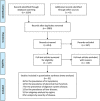The Prevalence of Gastrointestinal Symptoms, Abnormal Liver Function, Digestive System Disease and Liver Disease in COVID-19 Infection: A Systematic Review and Meta-Analysis
- PMID: 33116063
- PMCID: PMC7713642
- DOI: 10.1097/MCG.0000000000001424
The Prevalence of Gastrointestinal Symptoms, Abnormal Liver Function, Digestive System Disease and Liver Disease in COVID-19 Infection: A Systematic Review and Meta-Analysis
Abstract
Background: The worldwide outbreak of COVID-19 infected millions of people. Some patients had gastrointestinal (GI) symptoms, abnormal liver function, digestive system disease and liver disease.
Aim: To investigate the prevalence of GI symptoms, abnormal liver function, digestive system disease and liver disease in patients with COVID-19 by a systematic review and meta-analysis.
Methods: We searched PubMed, Ovid Embase, Medline, and 2 Chinese databases. Primary outcomes were the prevalence of GI symptoms, abnormal liver function, digestive system disease, and liver disease. Different studies were included in different subset analysis. These outcomes were estimated with proportions, odds ratio, 95% confidence interval (CI) and P-value by Stata SE 15.1.
Results: Thirty-one studies involving 4682 patients were included. The most significant GI symptoms were diarrhea (0.08, 95% CI: 0.06-0.11) and anorexia (0.17, 95% CI: 0.06-0.27). The most significant abnormal liver function was increased alanine aminotransferase (ALT) (0.25, 95% CI: 0.16-0.33). A total of 5% of the patients had digestive system disease (95% CI: 0.02-0.08). A total of 3% of the patients had liver disease (95% CI: 0.02-0.05). The prevalence of nausea and vomiting, diarrhea, abnormal liver function, digestive system disease, and liver disease was higher in Wuhan group. The prevalence of diarrhea was higher in non-China group. Patients in severe/intensive care unit group were more likely to have diarrhea, anorexia, abdominal pain increased aspartate aminotransferase, and increased ALT.
Conclusion: The most significant GI symptoms were anorexia and diarrhea. The most significant abnormal liver function was increased ALT. Severe patients were more likely to have GI symptoms and abnormal liver function.
Conflict of interest statement
The authors declare that they have nothing to disclose.
Figures





References
-
- World Health Organization. Naming the coronavirus disease (COVID-19) and the virus that causes it [World Health Organization]. Available at: www.who.int/emergencies/diseases/novel-coronavirus-2019/technical-guidan.... Accessed April 6 2020.
-
- World Health Organization. WHO Director-General’s opening remarks at the media briefing on COVID-19 - 3 April 2020 [World Health Organization]. 2020. Available at: www.who.int/dg/speeches/detail/who-director-general-s-opening-remarks-at.... Accessed April 6 2020.
-
- World Health Organization. WHO Director-General’s opening remarks at the media briefing on COVID-19 - 11 March 2020 [World Health Organization]. 2020. Available at: www.who.int/dg/speeches/detail/who-director-general-s-opening-remarks-at.... Accessed April 6 2020.
Publication types
MeSH terms
LinkOut - more resources
Full Text Sources
Medical

